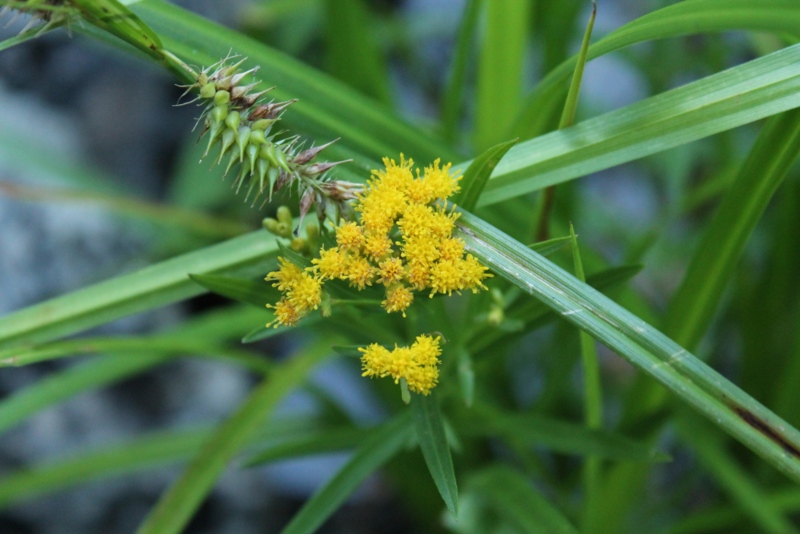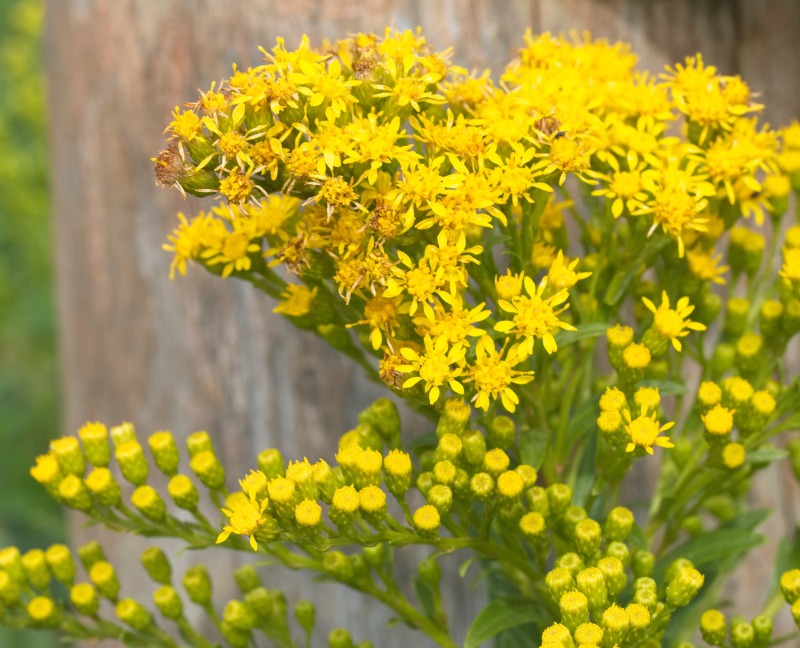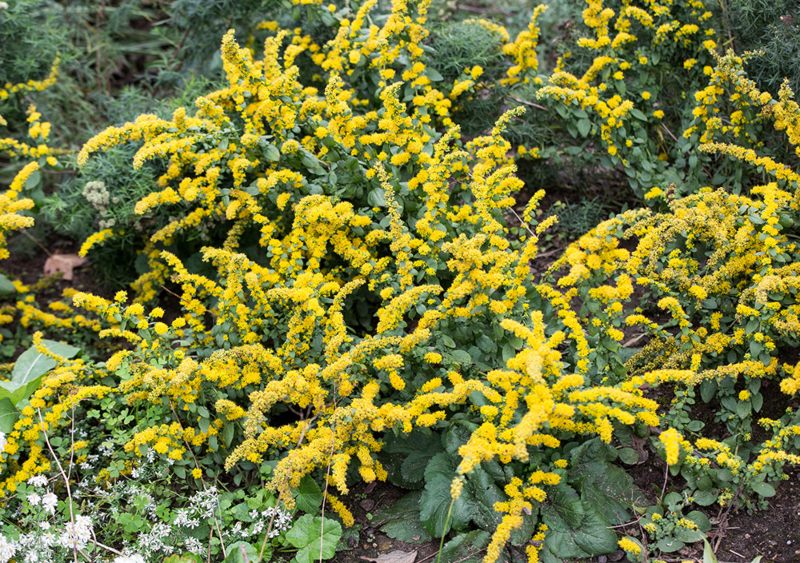
Goldenrod (Solidago) encompasses about 150 species worldwide with approximately 60 species growing wild throughout eastern North America. Although they are often considered a weed or invasive wildflower, goldenrod can be grown in flowerbeds to add a brilliant splash of color in the fall.
Most tolerate poor to moderate soil as long as it drains well and thrive in full to partial sun.
Because they can be invasive, care must be taken to plant them in areas where spreading is not an issue. Spreading can be controlled by deadheading the blooms as soon as they fade to prevent re-seeding and by digging them up and dividing the rhizomes every two to three years.
Consider the following varieties of goldenrod for your flowerbed or wildflower garden.
‘Zigzag’ goldenrod (Solidago flexicaulis)

‘Zig Zag’ goldenrod earns its name from its attractive zig zagging stems adorned with bright yellow blooms in the late summer and early fall. This variety grows to heights of 1 to 3 feet and thrives in USDA plant hardiness zones 3 through 8. ‘Zig Zag’ goldenrod prefers full sun to partial shade and thrives in poor to average well-drained soil. Plant ‘Zig Zag’ in your flowerbed for a showy display of color in the fall.
‘Bog’ goldenrod (Solidago uliginosa)

‘Bog’ goldenrod is one of the few goldenrod varieties that prefers wet soil. It can be found in wet, marshy or boggy areas and is ideal for planting in a sunny bog garden or around the perimeter of ponds and water features. This variety is hardy in USDA pant hardiness zone 3 through 8 and thrives in full sun. Flowers are held close to the stem atop 2-to-5-foot stalks creating delicate, yellow. wand-like plumes in late summer and early fall. ‘Bog’ goldenrod will not tolerate dry soil.
‘Seaside’ goldenrod (Solidago sempervirens)

‘Seaside’ goldenrod differs from other varieties in appearance as it produces tall slender stems atop basal foliage. Dense clusters of tiny, yellow blooms form a flower head atop 2-to-8-foot stalks in the fall. This goldenrod variety thrives in marshy and sandy areas along the east coast, it is hardy in USDA plant hardiness zone 3b through 8b and requires full sun. Plant seaside goldenrod along dunes or sandy areas on your coastal property.
‘White’ goldenrod (Solidago bicolor)

‘White’ goldenrod, also known as silver goldenrod, produces a spike of tiny, white flowers along the 1- to 3-foot stalk. Flowers sometimes appear yellow, but this is actually the color of the stamens in the center. The flower petals themselves are white. This variety will grow in nearly any light from full sun to shade and thrives in USDA plant hardiness zones 3 through 8. It is drought tolerant and requires well-drained soil. Tuck this variety into shaded areas to brighten them, or plant it next to other fall-blooming plants for contrast.
‘Golden Fleece’ goldenrod (Solidago sphacelate)

‘Golden Fleece’ goldenrod blooms on densely branched foliage in late summer or early fall creating the illusion of golden flower bouquets right in the garden. Plants grow to a height of a mere 1 to 3 feet with a spread to match. This variety thrives in USDA plant hardiness zones 4 through 9. Plant ‘Golden Fleece’ in well-drained soil in an area that receives full sun to partial shade. Its smaller stature makes ‘Golden Fleece’ a good choice for the middle of beds.
‘Fireworks’ goldenrod (Solidago rugosa)

‘Fireworks’ goldenrod blooms on arching stems radiating blooms in all directions, giving the illusion of cascading lemony-yellow fireworks in late summer and fall. This variety grows to heights of 3 to 6 feet with a spread to match. It thrives in USDA plant hardiness zones 5 through 9 and prefers full sun to partial shade. It tolerates dry soil and does not need supplemental watering unless there are long periods without rain. It will grow in nearly any soil type as long as it drains well. ‘Fireworks’ goldenrod works well as a specimen plant or as a filler in flowerbeds.
‘Stiff’ Goldenrod (Oligoneuron rigidum)

‘Stiff’ goldenrod is more upright than other varieties and does not arch or branch in the same fashion as others do. ‘Stiff’ goldenrod produces a flattened cluster of yellow blooms atop straight stems. This variety grows to heights of 4 feet and thrives in USDA plant hardiness zones 3 through 9. It prefers full sun but will grow in partial shade. ‘Stiff’ goldenrod is tolerant of nearly any soil type as long as it drains well.




